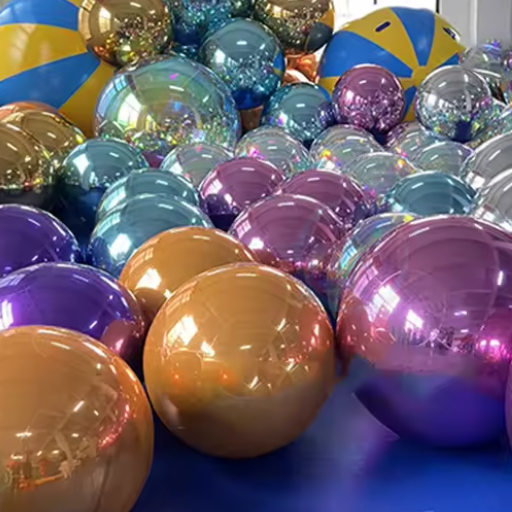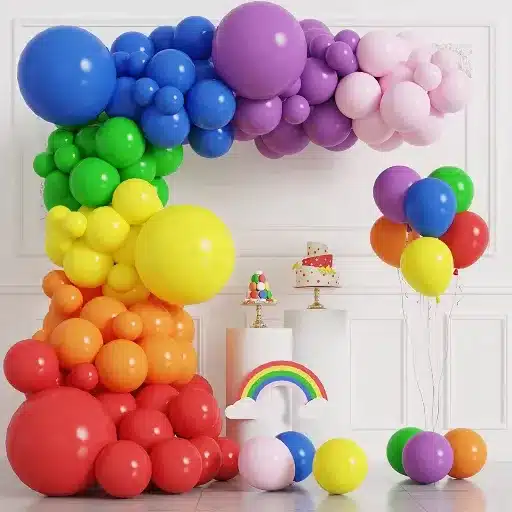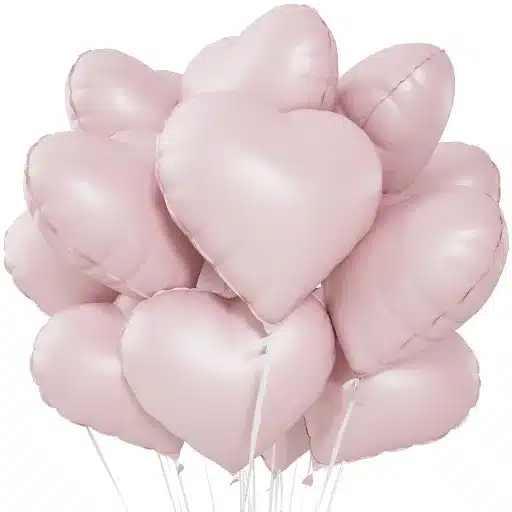Helium balloons are a major staple at celebrations, lending any occasion a touch of fun and festivity. Yet, if there was any query on how long these colorful decorations could stay afloat, you’re not alone. The float time for helium balloons varies significantly depending on several factors, including balloon type, external conditions, and handling.
This article will shed some light on the science and practicalities of helium balloon longevity, offering tips to keep them afloat for as long as possible, thereby maintaining their position as the star of your event. In case you are working on a party or are just curious about the mechanics behind these magical creations, read ahead for all the possible information.
Introduction to Helium Balloons

Helium gas serves to inflate the helium balloon with the light, non-flammable gas, thus enabling it to float. The flotation of helium balloons occurs because they are less dense than the surrounding air. Such balloons are standard at celebrations or any other event, available in various sizes, shapes, and materials, including latex, Mylar, and others. Although helium balloons are a treat for any festivity, their float times are minimal, depending on variables ranging from the material used for the balloon to environmental conditions. Proper love and care can extend their lifetime, which involves avoiding sharp objects and extremes of temperature.
What are Helium Balloons?
To describe them simply, these are inflatable adornments filled with helium gas, making them buoyant and capable of floating. They are generally used as decorations for events and celebrations due to their lightweight and festive designs.
Types of Helium Balloons: Latex vs Foil
| Parameter | Latex Balloons | Foil Balloons |
|---|---|---|
| Material | Rubber and water | Mylar with aluminum coating |
| Durability | Lasts 1 day | Lasts up to 1 week |
| Shape Options | Basic and twistable shapes | Wide variety, including characters |
| Cost | Affordable, ideal for bulk | Expensive, better for small quantities |
| Biodegradability | Fully biodegradable | Not recyclable |
| Inflation Options | Air or helium | Air or helium |
| Appearance | Matte or vibrant colors | Metallic and shiny |
| Best Use | Short-term events | Long-term or decorative events |
Why Choose Helium for Balloons?
Helium is a unique gas that possesses properties that make it ideal for inflating balloons used for celebrations and special events. One reason helium is used is that it is one of the lightest gases available, being much lighter than air. This ability to float makes helium-filled balloons magically perceived on any festive occasion.
Another safety consideration that increases the popularity of helium gas over others, such as hydrogen gas, which is lighter than air, is that it is non-flammable. The density of helium is 0.1786 g/L at standard temperature and pressure conditions, whereas air is 1.29 g/L; thus, helium floats much better in the atmosphere. Being inert chemically, it is less reactive and therefore not chemically reactive with the balloon material, making it safe for general use.
Key Benefits of Helium:
- Non-flammable and safe for general use
- Chemically inert – won’t react with balloon materials
- Significantly lighter than air (0.1786 g/l vs 1.29 g/l)
- Provides excellent buoyancy for floating balloons
Depending on the mixture used and the conditions, the lifespan of helium-filled balloons varies, with latex balloons floating anywhere between 8-12 hours while properly sealed foil balloons can float for days to weeks. The research also indicates that hi-float solutions can increase the float time of latex balloons markedly.
As the very presence of helium invites so much fun into events with balloon arches, bouquets, and releases, this particular gas has definitely captured a very pivotal role in the decoration scenario. Highly accessible and versatile in its applications, helium gas occupies a gamut of occasions from birthdays to weddings, and in its non-toxic form, it is a safe medium for children or adults to interact with, provided it is used responsibly.
How Long Will Helium Balloons Last?

The float time of helium balloons naturally depends on the type of balloon and the conditions it finds itself in. Latex helium balloons typically last 12 to 24 hours, but this duration can be extended to several days with hi-float treatment. Foil helium balloons tend to stay afloat the longest, from about 3 to 5 days and beyond, depending on mildew. The temperature, the humidity, and the elevation may affect the time a balloon can remain afloat. For best results, keep the balloons cool indoors, circulating air, and away from direct sunlight and any sharp objects.
Float Time of Different Balloon Types
| Balloon Type | Float Time | Key Notes |
|---|---|---|
| Latex Balloons | 8-12 hours | Porous material, helium escapes quickly |
| Latex with Hi-Float | 2-5 days | Hi-Float extends float time |
| Confetti Latex Balloons | 4-6 hours | Heavier due to confetti |
| Large Confetti Latex | 1-2 days | Larger size, no Hi-Float |
| Foil Balloons | 5-7 days | Less porous, helium lasts longer |
| Large Foil Balloons | Over a week | Larger size, extended float time |
Factors Impacting How Long Helium Balloons Last
Helium balloons have several factors determining their float time. Provided is the detailed list of five major influence factors:
🎈 Balloon Material
Latex balloons have a porous structure, allowing helium to escape faster, so the float time is less. Foil balloons being non-porous keep helium for a longer time.
🌡️ Temperature
Extreme temperatures have a huge effect on helium retention. At high temperatures, helium expands, causing leakage, while at low temperatures, helium contracts and starts to deflate.
🏔️ Altitude
Increased altitudes cause lower air pressure, which acts quickly to reduce helium and balloon floatation more than at sea level.
💧 Humidity
Another factor affecting latex balloons is high humidity, which weakens the balloons, hence faster helium escape. In short, keeping them dry will help prolong their life.
🔒 Sealing Method
Balloons get sealed or tied so helium escapes less. Such tightly knotted or heat-sealed balloons hold helium longer than those with loose knots.
Average Lifespan of Latex and Foil Balloons
A typical balloon may have an average lifespan that generally depends on its materials, weather conditions, and treatment given during sealing. Here is the detail:
Latex Balloons
Being a natural rubber, latex balloons are biodegradable but are also prone to helium leaks. Typically:
- Float Time with Helium: 8 to 12 hours indoors under normal conditions. This can be increased to 16 to 24 hours if treated specially with substances such as Hi-Float.
- Environmental Conditions: Direct sunlight, heat, or humidity considerably lessen their float times—sometimes with a loss of just a few hours.
Foil Balloons
Foil balloons being less porous than latex ones retain helium for quite a longer time. Typically:
- Float Time with Helium: 3 to 5 days. Depending upon quality and size, some foil balloons could keep afloat for up to a week or even longer.
- Better Retention: Being less vulnerable to environmental factors than latex, foil balloons are, however, susceptible to temperature changes that cause expansion or contraction.
Additional Data:
- According to industry sources, helium-treated latex balloons in ideal indoor conditions have extended float times and are said to have a lifespan up to 25 times longer.
- Bigger latex and foil balloons (like 18-inch or more) have a longer lifespan than smaller ones because they can hold more helium.
- Air-filled balloons, on the other hand, can last for a few days to weeks if they are made of latex, or months if they are made of foil, as long as they are not punctured.
Selecting the right materials and controlling environmental factors will lend to the enhancement of the lifespan of both latex and foil balloons for different occasions.
Tips to Extend the Float Time of Helium Balloons

-
1
Select Quality Balloons
Premium-quality latex or foil balloons are less likely to leak and can hold helium for extended periods. Opt for balloons made of thicker material to decrease the rate at which helium escapes.
-
2
Store in a Cool Place
Heat allows helium to expand thus making leaks more probable, while direct sunlight can harm latex balloons. Hence, always store these balloons in a cool, shaded place to increase their float time.
-
3
Use Hi-Float Treatment
The application of Hi-Float, or a similar product, creates a barrier inside latex balloons that slows the leaking of helium. This treatment can increase the float time up to 25 times longer than for untreated balloons.
-
4
Avoid Over-Inflation
Over-inflating puts strain on balloons, making them prone to bursting. Always inflate balloons to the specified size to ensure the best durability and float time.
-
5
Properly Lace Balloons Together
Ensure they are well-tied and professionally sealed. For latex balloons, use strong balloon clips or securely wrap the neck to prevent helium from escaping through the knot.
Best Practices for Inflating Balloons
Use Qualified Inflators
Using a helium or air inflator designed for balloons is ideal. Professional inflators save time and offer consistent, precise inflation, preventing over-inflation of the balloons.
Structure and Monitor Inflation Pressure
Maintaining a pressure watch is recommended while inflating balloons: latex, in particular, are supposed to be filled just until the surface looks smooth without any kind of overstretching. In case of over-inflation, it will weaken the latex and could lead to premature bursting.
Pre-stretch the Latex Balloons
Pre-stretching the latex balloons slightly before inflating can increase the balloons’ elasticity and their ability to hold air or helium. In turn, this helps to meet the specified size and to improve the durability of the balloons.
Inflate According to the Specification Sizes
Usually, refer to the suggested sizes provided by the manufacturer for each balloon type; they are typically specified in inches or centimeters. For instance, the size of an 11-inch latex balloon should not exceed its designated size because in the case of over-inflating, it would reduce flying time and durability.
Test Float Time for Helium Balloons
If helium is used at the event, two balloons should be tested for their optimal float time in the location of the event itself. Changes in temperature and humidity, along with altitude, could change the actual balloon float time, and being able to test before greatly benefits event preparation.
Using Balloon Treatments to Maintain Helium
Balloon treatments are those specialized solutions that prevent helium-filled balloons from dropping soon. Treatments like Hi-Float form an internal protective coating within the balloons, thus limiting the passage of helium through the latex with tiny pores. The manufacturers claim that treating a latex balloon before inflation boosts its float time with 25 times as much as an untreated balloon, making helium balloons float for a few days instead of a few hours.
For example, normal untreated 11-inch latex balloons float for 12-24 hours. But with an appropriate balloon treatment, the float can be maintained for 2-3 days in ideal conditions. To apply, one would use a pump or dispenser to inject the required small amount of solution inside the balloon. Before filling the balloons with helium, the balloon is then gently massaged to ensure an even application of the protective coating.
Using balloon treatments requires considering several other factors, such as environmental elements. High temperatures and extreme humidity will still interfere with the adhesion of treatments and thus the overall float time of the balloon. Moreover, for an outdoor event, one should also consider wind and sun exposure, as they further reduce the efficiency of treated balloons.
Balloon treatments allow planners to preserve their decorative arrangements for an extended period, thereby maintaining their festive nature throughout the celebrations. This method has become highly regarded for its use in big events and installations where ensuring float times is paramount.
Environmental Factors That Affect Balloon Longevity
In planning balloon decorations for an event, it is considered essential to be aware of the environmental factors that influence their longevity. The following are five key factors that affect the inflation and visual appeal of balloons for varying durations:
🌡️ Temperature
Temperature extremes very much influence balloons. When the temperature is too high, gases, especially helium or air, inside the balloon expand, promoting bursting. When the temperature is low, gases contract, causing balloons to shrink or appear deflated. Ideal temperatures for balloons range from 68°F to 77°F (20 °C to 25°C).
💧 Humidity
High humidity can affect balloon life, especially for latex balloons. Moisture in the air weakens latex, resulting in quicker float time or causing the balloons to sag. The use of balloon treatment can help mitigate this adverse effect.
☀️ UV Exposure
The longer balloons are exposed to direct sunlight and ultraviolet rays, the faster their materials degrade. Latex balloons are especially susceptible; they may turn brittle and discolored in just a few hours. Consider shading the areas or applying a UV-resistant coating.
💨 Wind
Strong winds cause physical stress for balloons: tangling, popping, or wear and tear. Securing balloons with weight anchors and designing for wind resistance are important considerations for outdoor use.
🏔️ Altitude
Higher altitudes, featuring lower atmospheric pressure, pose a significant risk of balloon expansion, with a greater chance of bursting. Helium balloons are most significantly affected by altitude changes due to transportation or use in mountainous areas. Adjusting the inflation levels will help reduce this.
By understanding these environmental factors, any event planner can preserve the durability and effectiveness of balloon decorations while carrying the visual appeal of their decorations through the event.
Conclusion: Making the Most of Your Helium Balloons

In order to correctly make use of your helium balloons, a range of proper handling methods and some kind of planning must be taken into consideration. Research indicates that helium balloons generally remain afloat for 12 to 24 hours under normal circumstances, whereas foil balloons may last 5 days or even much more when well sealed. The balloons, therefore, should be inflated right before the event, giving them maximum time to be appreciating beauty and utilization.
Other things to consider are temperature and direct sunlight affecting balloon performance. High heat causes helium expansion and increases the possibility of bursting, while low temperature shrinkage would otherwise deflate balloons prematurely. Studies also indicate that sealing latex balloons with an agent like Hi-Float can extend their float time by up to 25 times their normal duration, making it an excellent option for a longer event.
Consideration must also be made for the ecological factors – opt for biodegradable latex balloons and always ensure the responsible disposal of the materials involved. By keeping yourself updated on the latest techniques and materials, you’ll then be able to create impressive decorations with a lasting touch while also contributing to sustainable event practices.
Final Tips for Party Decorations
🎨 Plan a Color Scheme Using HomeGDS Colors
In general, select one color family for decorating purposes to form an attractive visual theme. Studies reveal that color plays a significant role in instilling a certain mood, with reds and oranges evoking energy and blues and greens inducing a relaxed feeling.
💡 Play with Lighting
Incorporate string lights, fairy lights, or LED uplighting to keep the mood rolling for your party. Event planners would allocate around 20 percent of the space to down-home decor, creating a very open and lively ambiance.
♻️ Buy Reusable Decorations
High-quality reusable items should be chosen such as fabric banners, holders for candles, or arrangements of artificial flowers. This cuts down on waste while also allowing you to save 30% on the next purchase.
🎪 Make Interaction
Opt for decorative pieces that can engage with guests, such as a photo booth with props and a DIY dessert table. Results show an interactive 70% causes guests to enjoy an event more.
🍽️ Table Settings Matter
Coordinate your tablecloth, centerpiece, and dishware to provide a pleasant dining experience. For a little more glam, give texture-layering a shot-wool napkins and metallic chargers-while also including those cute little touches that make guests feel extra-special (think place cards).
References
- BalloonAscent: 3-D simulation tool for the ascent and float of high-altitude balloons
This paper discusses the factors influencing balloon flight, including helium dynamics.
Read more here - Scientific Ballooning: Technology and applications of exploration balloons floating in the stratosphere and the atmospheres of other planets
This book provides insights into the use of helium in balloons for long-distance and experimental flights.
Read more here - Design, Optimization and Additive Manufacture of a Generalized Helium Outflow Unit for Latex Balloons to Float
This study focuses on helium outflow and its impact on the float time of latex balloons.
Read more here
Frequently Asked Questions (FAQ)
❓ How long do helium balloons last?
A helium balloon usually floats for around 8 to 12 hours. The time it can spend in the air will alter due to factors like the material of the balloon as well as the environmental setting.
🌡️ What affects the duration of hovering in helium balloons?
Foil balloons last for a shorter duration, while latex balloons hover for a fairly long time. Temperature and humidity conditions also influence their floating time.
🎈 How do I prevent my latex helium balloons from deflating so soon?
To boost the float time of latex helium balloons, one could try to use Hi-Float. Hi-Float is a thin liquid that you apply inside the balloon before filling it with helium. It forms a sort of coat inside the balloon that helps prevent helium from leaking out.
✨ Are mylar foil balloons longer-lived than latex ones?
Yes. Generally, mylar foil balloons last much longer than latex balloons. Since Mylar is far less porous than latex, it can usually retain helium for days or even weeks, while latex balloons may only float for a few hours to a day.
💨 How long would they float if helium balloons were filled with air?
If helium balloons are filled with air, they won’t float. Filling them with helium gas imparts buoyancy and keeps them parked aloft. If you give the same balloon a filling of air, it will just deflate and hit the ground.
🎪 Why should bigger balloons be used for parties?
Being larger in size, these balloons create a greater volume and hold more helium, resulting in a longer time for floating than their smaller counterparts. This proves to be an excellent advantage for party decorations, as larger balloons stay afloat for a longer time.
🔒 How do I keep my balloons from deflating quickly?
Ensure that your balloons have sufficient helium to prevent them from deflating quickly, along with Hi-Float, which helps seal the inside of the balloon. Actually, placing them indoors and away from a heat source can also help maintain their floating time.
☀️ Will the balloons float outdoors in hot weather?
They might float for some time outside during hot weather, with the temperature melting off the ability of the Mechanism.
⏰ How long is mylar helium balloons compared with latex?
Generally, mylar helium balloons remain inflated for much longer periods than latex balloons. While latex balloons might only float for approximately two or three hours, mylar balloons can float for several days, therefore providing a perfect setting for extended events or parties.









